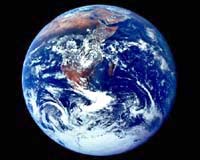
 |
Ocean levels rose by between 15 and 20 centimetres (six and eight inches) in the 20th century, most of which can be attributed to runoff from melting ice on land, it says.
The research compares with estimates which put the rate of rise lower and which blame most of that on thermal expansion rather than ice melt.
Under thermal expansion, the sea expands as it warms, and thus rises.
The study, published on Thursday in the British weekly journal Nature, checked and validated the use of tide gauges -- floating indicators usually attached to piers -- as an accurate guide to sea levels in the past.
That tool had been attacked as unreliable by some climate experts, who claimed the gauge data could be distorted by local maritime factors.
Taking a cautious line, the UN's Intergovernmental Panel on Climate Change (IPCC) in 2001 estimated that the sea rise in the 20th century was 15cm (six inches) on average, of which about 10cm (four inches) could be attributed to thermal expansion.
The new study is authored by Laury Miller of the US National Oceanic and Atmospheric Administration (NOAA) and Bruce Douglas of the Laboratory for Coastal Research at Florida International University.
In a phone interview with AFP, Miller said melting ice on land, disgorging water into the sea, could be the only conceivable reason for rising ocean levels.
"The challenge now is for glaciologists to look at the data and identify the source for it," he said.
Previous studies have already said that glaciers and low-altitude snow and ice in many parts of the the world are shrinking as a result of global warming.
The biggest icesheets are located in Greenland and Antarctica. Greenland's icesheet is vulnerable to erosion in the next century, according to the IPCC, but it estimated there was little risk, outside of a catastrophic rise in temperatures, of any major damage to its far bigger counterpart in Antarctica.
If the icecap on the North Pole melted, that would not cause ocean levels to rise, because this ice floats on water, not land, and so displaces its own weight.
The melting, though, could have a big impact on ocean currents, notably braking the balmy North Atlantic Drift and plunging northwestern Europe into an Ice Age, according to some scenarios.
Ocean levels are a core factor in the impact of man-made global warming on Earth's fragile climate system.
Even a tiny annual rise is significant if it continues over a long period.
This is because the effect can be amplified many times through higher tides, worsening coastal erosion and storms that reach further inland.
Around 100 million people live in small island states, low-lying or delta areas that are within one metre (3.25 feet) of sea level, according to some estimates.
The uncertainty and intense debate over sea levels caused the IPCC to hedge its bets in its 2001 estimate, suggesting an enormous range in the potential rise from just nine centimetres to 88 centimetres (four to 35 inches) from 1990 to 2100.
At the far end of this range, vulnerable areas would be swamped or rendered uninhabitable.
Those estimates in turn depend partly on the rise in global temperatures, driven by the "greenhouse" effect caused by uncontrolled burning of fossil fuels.
Over the 20th century the increase was 0.6 C (1.08 F), plus or minus 0.2 C (0.4 F), the IPCC said, estimating the range for 1990-2100 to be between 1.4 to 5.8 C (2.5 to 10.4 F).
TERRA.WIRE |